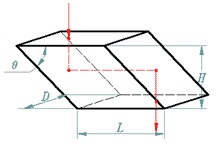1. Germanium (Ge)
Germanium (Ge) is the preferred lens and window material for high performance infrared imaging systems in the 8–12 μm wavelength band. Its high refractive index makes Ge ideal for low power imaging systems because of minimum surface curvature. Chromatic aberration is small, often eliminating the need for correction.
|
Crystallographic properties
|
|
Syngony
|
Cubic
|
|
Crystal Form
|
Poly or Single Crystal
|
|
Lattice Constant
|
5.66
|
|
Cleavability
|
<111>, non-perfect
|
|
Molecular Weight
|
72.6
|
|
Physical properties
|
|
Density, at 20 °C
|
5.33
|
|
Hardness, Mohs
|
6.3
|
|
Dielectric Constant for 9.37 × 109 Hz at 300 K
|
16.6
|
|
Melting
|
937
|
|
Thermal Conductivity, W/m·K at at 293 K
|
59
|
|
Thermal Expansion, 1/K at 298 K
|
6.1 × 10-6
|
|
Specific Heat Capacity, J/(kgK) at 273-373 K
|
0.074
|
|
Bandgap, eV
|
0.67
|
|
Knoop Hardness, kg/mm2
|
800
|
|
Youngs Modulus, Gpa
|
102.66
|
|
Shear Modulus, GPa
|
67.04
|
|
Bulk Modulus, GPa
|
77.86
|
|
Debye Temperature, K
|
370
|
|
Poissons Ratio
|
0.278
|
|
Elastic Coefficient
|
C11=129, C12=48.3, C44=67.1
|
|
Apparent Elastic Limit
|
89.6 MPa (13000psi)
|
|
Chemical properties
|
|
Solubility in water
|
None
|
|
Solubility in acids
|
Soluble
|
|
Molecular Weight
|
72.59
|
2. Silicon (Si)
Silicon (Si) is grown by Czochralski pulling techniques (CZ) and contains some oxygen that causes an absorption band at 9 microns.To avoid this, material can be prepared by a Float-Zone (FZ) process. Optical silicon is generally lightly doped (5 to 40 ohm cm) for best transmission above 10 microns, and doping is usually boron (P-type) and phosphorus (N-type). After doping silicon has a further pass band: 30 to 100 microns which is effective only in very high resistivity uncompensated material.
CZ Silicon is commonly used as substrate material for infrared reflectors and windows in the 1.5-8 micron region. The strong absorption band at 9 microns makes it unsuitable for CO2 laser transmission applications, but it is frequently used for laser mirrors because of its high thermal conductivity and low density. Application as window, lens in the 1.5 - 8 um region; Mirror for CO2 laser and spectrometer applications.
|
Crystallographic properties
|
|
Syngony
|
Cubic
|
|
Lattice Constant, A
|
5.43
|
|
Physical properties
|
|
Density
|
2.33g/cm3
|
|
Hardness, Mohs
|
7
|
|
Dielectric Constant for 9.37 x 109 Hz
|
13
|
|
Melting point, оС
|
1414
|
|
Thermal Conductivity, W/m·K at 313 K
|
163
|
|
Thermal Expansion, 1/K at 293 K
|
2.6x10-6
|
|
Specific Heat Capacity, J/(kg°C)
|
712.8
|
|
Bandgap, eV
|
1.1
|
|
Knoop Hardness, kg/mm2
|
1100
|
|
Youngs Modulus, Gpa
|
130.91
|
|
Shear Modulus, GPan
|
79.92
|
|
Bulk Modulus, GPa
|
101.97
|
|
Debye Temperature, K
|
640
|
|
Poissons Ratio
|
0.28
|
|
Chemical properties
|
|
Solubility in water
|
None
|
|
Molecular Weight
|
28.09
|
3、ZnS material:
ZnS MultiSpectral Under intense heat and pressure, defects within the crystalline lattice are virtually eliminated, leaving a water-clear material with minimal scatter and high transmission characteristics from 0.4 to 12 microns. This material is particularly well suited for high-performance common aperture systems that must perform across a broad wavelength spectrum.
Specifications:
Material: ZnS MultiSpectral
Diameter Tolerance: --------------------- +0.0, -0.1mm
Thickness Tolerance: -------------------- ±0.1mm
Clear Aperture: ---------------------------->85%
Parallelism: -----------------------------------3 arc minute
Surface Quality: ----------------------------80-50 scratch and dig
Wavefront Distortion: -------------------- λ /2 per 25mm @633mm
Bevel: -----------------------------------------Protective (<0.2mm x 45° )
Coating: -------------------------------------- Optional (Uncoated, AR Coating, etc.)
4. ZnSe material
ZnSe is a preferred material for lenses, windows, output couplers and beam expanders for its low absorptivity at infrared wavelengths and its visible transmission. For high-power applications, it’s critical that the material bulk absorption and internal defect structure be carefully controlled, that minimum-damage polishing technology be employed, and the highest quality optical thin-film coatings are used. The material absorption is verified by CO2 laser vacuum calorimetry. Our quality assurance department provides testing and specific optics certification on request.
ZnSe is non-hygroscopic and chemically stable, unless treated with strong acids. It’s safe to use in most industrial field, and laboratory environments.

